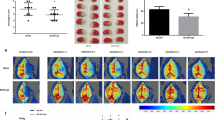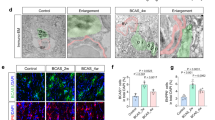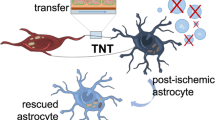Abstract
Here we show that ischemia induces sustained contraction of pericytes on microvessels in the intact mouse brain. Pericytes remain contracted despite successful reopening of the middle cerebral artery after 2 h of ischemia. Pericyte contraction causes capillary constriction and obstructs erythrocyte flow. Suppression of oxidative-nitrative stress relieves pericyte contraction, reduces erythrocyte entrapment and restores microvascular patency; hence, tissue survival improves. In contrast, peroxynitrite application causes pericyte contraction. We also show that the microvessel wall is the major source of oxygen and nitrogen radicals causing ischemia and reperfusion–induced microvascular dysfunction. These findings point to a major but previously not recognized pathophysiological mechanism; ischemia and reperfusion-induced injury to pericytes may impair microcirculatory reflow and negatively affect survival by limiting substrate and drug delivery to tissue already under metabolic stress, despite recanalization of an occluded artery. Agents that can restore pericyte dysfunction and microvascular patency may increase the success of thrombolytic and neuroprotective treatments.
This is a preview of subscription content, access via your institution
Access options
Subscribe to this journal
Receive 12 print issues and online access
$209.00 per year
only $17.42 per issue
Buy this article
- Purchase on Springer Link
- Instant access to full article PDF
Prices may be subject to local taxes which are calculated during checkout






Similar content being viewed by others
References
Juttler, E., Kohrmann, M. & Schellinger, P.D. Therapy for early reperfusion after stroke. Nat. Clin. Pract. Cardiovasc. Med. 3, 656–663 (2006).
Molina, C.A. & Saver, J.L. Extending reperfusion therapy for acute ischemic stroke: emerging pharmacological, mechanical, and imaging strategies. Stroke 36, 2311–2320 (2005).
Lo, E.H., Dalkara, T. & Moskowitz, M.A. Mechanisms, challenges and opportunities in stroke. Nat. Rev. Neurosci. 4, 399–415 (2003).
Abbott, N.J., Ronnback, L. & Hansson, E. Astrocyte-endothelial interactions at the blood-brain barrier. Nat. Rev. Neurosci. 7, 41–53 (2006).
Little, J.R., Kerr, F.W. & Sundt, T.M. Jr. Microcirculatory obstruction in focal cerebral ischemia. Relationship to neuronal alterations. Mayo Clin. Proc. 50, 264–270 (1975).
del Zoppo, G.J., Schmid-Schonbein, G.W., Mori, E., Copeland, B.R. & Chang, C.M. Polymorphonuclear leukocytes occlude capillaries following middle cerebral artery occlusion and reperfusion in baboons. Stroke 22, 1276–1283 (1991).
Little, J.R., Kerr, F.W.L. & Thoralf, M.S. Microcirculatory obstruction in focal cerebral ischemia: an electron microscopic investigation in monkeys. Stroke 7, 25–30 (1976).
Hallenbeck, J.M. et al. Polymorphonuclear leukocyte accumulation in brain regions with low blood flow during the early postischemic period. Stroke 17, 246–253 (1986).
del Zoppo, G.J. & Mabuchi, T. Cerebral microvessel responses to focal ischemia. J. Cereb. Blood Flow Metab. 23, 879–894 (2003).
Garcia, J.H., Liu, K.F., Yoshida, Y., Chen, S. & Lian, J. Brain microvessels: factors altering their patency after the occlusion of a middle cerebral artery (Wistar rat). Am. J. Pathol. 145, 728–740 (1994).
Ohtake, M., Morino, S., Kaidoh, T. & Inoue, T. Three-dimensional structural changes in cerebral microvessels after transient focal cerebral ischemia in rats: scanning electron microscopic study of corrosion casts. Neuropathology 24, 219–227 (2004).
Peppiatt, C.M., Howarth, C., Mobbs, P. & Attwell, D. Bidirectional control of CNS capillary diameter by pericytes. Nature 443, 700–704 (2006).
Chan, P.H. Role of oxidants in ischemic brain damage. Stroke 27, 1124–1129 (1996).
Chong, Z.Z., Li, F. & Maiese, K. Oxidative stress in the brain: novel cellular targets that govern survival during neurodegenerative disease. Prog. Neurobiol. 75, 207–246 (2005).
Heo, J.H., Han, S.W. & Lee, S.K. Free radicals as triggers of brain edema formation after stroke. Free Radic. Biol. Med. 39, 51–70 (2005).
Gürsoy-Ozdemir, Y., Bolay, H., Saribas, O. & Dalkara, T. Role of endothelial nitric oxide generation and peroxynitrite formation in reperfusion injury after focal cerebral ischemia. Stroke 31, 1974–1980 (2000).
Gürsoy-Ozdemir, Y., Can, A. & Dalkara, T. Reperfusion-induced oxidative/nitrative injury to neurovascular unit after focal cerebral ischemia. Stroke 35, 1449–1453 (2004).
Gibson, C.L., Coughlan, T.C. & Murphy, S.P. Glial nitric oxide and ischemia. Glia 50, 417–426 (2005).
Iadecola, C., Zhang, F., Casey, R., Nagayama, M. & Ross, M.E. Delayed reduction of ischemic brain injury and neurological deficits in mice lacking the inducible nitric oxide synthase gene. J. Neurosci. 17, 9157–9164 (1997).
Newell, D.W., Barth, A., Papermaster, V. & Malouf, A.T. Glutamate and non-glutamate receptor mediated toxicity caused by oxygen and glucose deprivation in organotypic hippocampal cultures. J. Neurosci. 15, 7702–7711 (1995).
Liu, S., Connor, J., Peterson, S., Shuttleworth, C.W. & Liu, K.J. Direct visualization of trapped erythrocytes in rat brain after focal ischemia and reperfusion. J. Cereb. Blood Flow Metab. 22, 1222–1230 (2002).
Wei, E.P., Kontos, H.A. & Beckman, J.S. Mechanisms of cerebral vasodilation by superoxide, hydrogen peroxide, and peroxynitrite. Am. J. Physiol. 271, H1262–H1266 (1996).
Hossmann, K.A. Pathophysiology and therapy of experimental stroke. Cell. Mol. Neurobiol. 26, 1057–1084 (2006).
Li, P.A. et al. Capillary patency after transient middle cerebral artery occlusion of 2 h duration. Neurosci. Lett. 253, 191–194 (1998).
Allt, G. & Lawrenson, J.G. Pericytes: cell biology and pathology. Cells Tissues Organs 169, 1–11 (2001).
Balabanov, R. & Dore-Duffy, P. Role of the CNS microvascular pericyte in the blood-brain barrier. J. Neurosci. Res. 53, 637–644 (1998).
Bandopadhyay, R. et al. Contractile proteins in pericytes at the blood-brain and blood-retinal barriers. J. Neurocytol. 30, 35–44 (2001).
Kamouchi, M. et al. Hydrogen peroxide–induced Ca2+ responses in CNS pericytes. Neurosci. Lett. 416, 12–16 (2007).
Chrissobolis, S. & Sobey, C.G. Recent evidence for an involvement of rho-kinase in cerebral vascular disease. Stroke 37, 2174–2180 (2006).
Rees, D.D., Palmer, R.M., Schulz, R., Hodson, H.F. & Moncada, S. Characterization of three inhibitors of endothelial nitric oxide synthase in vitro and in vivo. Br. J. Pharmacol. 101, 746–752 (1990).
Huang, Z. et al. Effects of cerebral ischemia in mice deficient in neuronal nitric oxide synthase. Science 265, 1883–1885 (1994).
Faraci, F.M. Reactive oxygen species: influence on cerebral vascular tone. J. Appl. Physiol. 100, 739–743 (2006).
Pacher, P., Beckman, J.S. & Liaudet, L. Nitric oxide and peroxynitrite in health and disease. Physiol. Rev. 87, 315–424 (2007).
Ames, A., III, Wright, R.L., Kowada, M., Thurston, J.M. & Majno, G. Cerebral ischemia. II. The no-reflow phenomenon. Am. J. Pathol. 52, 437–453 (1968).
Fischer, E.G. Impaired perfusion following cerebrovascular stasis. A review. Arch. Neurol. 29, 361–366 (1973).
Crowell, R.M. & Olsson, Y. Impaired microvascular filling after focal cerebral ischemia in the monkey. Modification by treatment. Neurology 22, 500–504 (1972).
Ritter, L.S., Orozco, J.A., Coull, B.M., McDonagh, P.F. & Rosenblum, W.I. Leukocyte accumulation and hemodynamic changes in the cerebral microcirculation during early reperfusion after stroke. Stroke 31, 1153–1161 (2000).
Anwar, M., Buchweitz-Milton, E. & Weiss, H.R. Effect of prazosin on microvascular perfusion during middle cerebral artery ligation in the rat. Circ. Res. 63, 27–34 (1988).
Folbergrová, J., Zhao, Q., Katsura, K. & Siesjo, B.K. N-tert-butyl-α-phenylnitrone improves recovery of brain energy state in rats following transient focal ischemia. Proc. Natl. Acad. Sci. USA 92, 5057–5061 (1995).
Belayev, L. et al. Albumin therapy of transient focal cerebral ischemia: in vivo analysis of dynamic microvascular responses. Stroke 33, 1077–1084 (2002).
Verdouw, P.D., Jennewein, H.M., Heiligers, J., Duncker, D.J. & Saxena, P.R. Redistribution of carotid artery blood flow by 5-HT: effects of the 5–HT2 receptor antagonists ketanserin and Wal 1307. Eur. J. Pharmacol. 102, 499–509 (1984).
Hudetz, A.G. Blood flow in the cerebral capillary network: a review emphasizing observations with intravital microscopy. Microcirculation 4, 233–252 (1997).
Ozerdem, U., Grako, K.A., Dahlin-Huppe, K., Monosov, E. & Stallcup, W.B. NG2 proteoglycan is expressed exclusively by mural cells during vascular morphogenesis. Dev. Dyn. 222, 218–227 (2001).
Wu, D.M., Kawamura, H., Sakagami, K., Kobayashi, M. & Puro, D.G. Cholinergic regulation of pericyte-containing retinal microvessels. Am. J. Physiol. Heart Circ. Physiol. 284, H2083–H2090 (2003).
Acknowledgements
This work was supported by The Turkish Academy of Sciences (T.D. and Y.G.-O.), Hacettepe University Research Fund 0401105001 (T.D.), Scientific and Technical Research Council of Turkey 104S254 (Y.G.-O.), Ankara University Biotechnology Institute 2001K120240 (A.C.) and Brain Research Association (M.Y.). We are grateful to M.A. Moskowitz for his support and comments. Part of this study was presented at the Society For Neuroscience 37th Annual Meeting in San Diego, California, 2007.
Author information
Authors and Affiliations
Contributions
M.Y. performed the in vivo experiments and histology studies and contributed to the in vitro studies, design of the experiments, data analyses and preparation of the figures; Y.G.-O. conducted and performed the intravital microscopy experiments and in vitro studies and contributed to the histology studies, design of the experiments and preparation of the figures; A.V. contributed to the intravital microscopy experiments and in vitro studies, performed image analyses and contributed to the preparation of the figures; A.C. conducted the confocal and DIC microscopy studies and prepared the figures; K.T. contributed to the in vivo experiments and performed the in vivo experiments with knockout mice; T.D. designed and supervised the project, contributed to the data analyses and wrote the manuscript.
Corresponding author
Supplementary information
Supplementary Text and Figures
Supplementary Figures 1–3, Supplementary Data and Supplementary Methods (PDF 1850 kb)
Rights and permissions
About this article
Cite this article
Yemisci, M., Gursoy-Ozdemir, Y., Vural, A. et al. Pericyte contraction induced by oxidative-nitrative stress impairs capillary reflow despite successful opening of an occluded cerebral artery. Nat Med 15, 1031–1037 (2009). https://doi.org/10.1038/nm.2022
Received:
Accepted:
Published:
Issue Date:
DOI: https://doi.org/10.1038/nm.2022
This article is cited by
-
The role of cardiac pericytes in health and disease: therapeutic targets for myocardial infarction
Nature Reviews Cardiology (2024)
-
Bicarbonate signalling via G protein-coupled receptor regulates ischaemia-reperfusion injury
Nature Communications (2024)
-
Brain Maturation as a Fundamental Factor in Immune-Neurovascular Interactions in Stroke
Translational Stroke Research (2024)
-
Systemic Immune-Inflammation Response is Associated with Futile Recanalization After Endovascular Treatment
Neurocritical Care (2024)
-
Acute subdural haematoma exacerbates cerebral blood flow disorder and promotes the development of intraoperative brain bulge in patients with severe traumatic brain injury
European Journal of Medical Research (2023)



